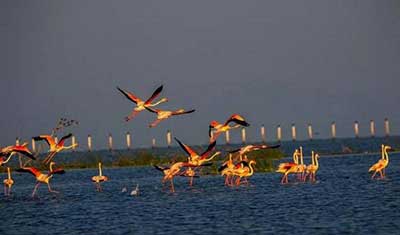Relevance: GS-3: Conservation, environmental pollution and degradation, environmental impact assessment
Key phrases: Chilika Lake, Waterbird census, Lagoon, UNESCO World Heritage Site, Ramsar site, ecological concern.
Why in News?
- Chilika Lake, the largest brackish water lake and wintering ground of the birds in the Indian subcontinent, saw a million of birds, including uncommon Mongolian gull, visiting the waterbody this year.
Chilika Lake:
- Chilika Lake is a brackish water lake and a shallow lagoon with estuarine character spread across the districts of Puri, Khurda and Ganjam in the state of Odisha in eastern India.
- The lagoon can be broadly divided into four ecological sectors based on salinity and depth, namely the southern zone, the central zone, the northern zone and the outer channel. A number of islands are present in the lagoon, prominent among which are Krushnaprasad, Nalaban, Kalijai, Somolo and Birds Islands.

Feature of Chilika lake:
- Chilika is Asia’s largest and world’s second largest lagoon.
- It has been designated as a Ramsar Site and a possible UNESCO World Heritage Site.
- Chilika Lake was declared as the first Ramsar Convention wetland of international importance in India in 1981.
- It is home to a number of vulnerable plant and animal species and is the major wintering site for migratory birds in the Indian subcontinent.
- Major attraction at Chilika is Irrawaddy dolphins which are often spotted off Satpada Island.
Water Bird Status Survey-2022
- The census was undertaken jointly by the Odisha State Wildlife Organization, the Chilika Development Authority (CDA) and the Bombay Natural History Society. A total of 106 personnel, including bird experts from government and non-government organisations, were deployed.
- A total of 3,58,889 birds (97 species) were counted in Nalabana Bird Sanctuary inside Chilika – a decrease by 65,899 from the previous year. The decrease is attributed to high water level and presence of water in cultivated fields in adjoining areas. Water birds love to flock on large mudflats.
- There was marginal decrease in the number of species such as the northern shoveler, tufted duck and red crested pochard. An increase in population of northern pintail, common coot and common pochard was noticed.
- The increase in numbers for the greater flamingo at Nalabana mudflat indicates that the restoration at Nalabana is effective. This year’s greater flamingo count was highest in last one decade. It is largely due to appropriate management of mudflats, the CDA said. Overall, the local resident species such as purple swamp-hen, purple heron, Indian moorhen, and jacanas were found in higher numbers.
- Acc. To survey Chilika lake hosts birds migrating from thousands of miles away from the Caspian Sea, Lake Baikal, Aral Sea, remote parts of Russia, Kirghiz steppes of Mongolia, Central and South East Asia, Ladakh and the Himalayas. The winged guests find the vast mud-field and abundant fish stock here suitable to congregate.
Ecological problems in the Chilika lagoon:
The ecological problems in the Chilika lagoon are:
- Siltation due to littoral drift and sediments from the inland river systems.
- Shrinkage of water surface area.
- Choking of the inlet channel as well as shifting of the mouth connecting to the sea.
- Decrease in salinity and fishery resources.
- Proliferation of fresh water invasive species an overall loss of biodiversity with decline in productivity adversely affecting the livelihood of the community that depended on it.
Measures for restoring the Chillika Lake:
- Abolition of shrimp culture and demolition of shrimp ‘gheris’ which disrupt the tidal flushing, reduced the level of salinity, squeeze grazing ground for juveniles and accelerate the process silting of marginal areas of the Lake.
- Restrictions on mechanized boats in Chilika as they pollute the water and hamper the growth of surface fish.
- Ban on ‘zero net’ as it destroys seedlings of various fish, shrimp and crab and thus reduce its stock.
- Ban on fishing by trawlers in the Bay of Bengal near Chilika since they obstruct the entry of fish and shrimp from sea to Lake
- Removal of floating aquatic weeds particularly in the western and northern sources of Chilika as they increase siltation and obstruct movement of boats.
Benefits obtained after a few restoration efforts:
- The Chilika lagoon is a striking example of how the restoration of the ecological characteristics of a site results not only in improvement of the lagoon ecosystem but also benefits the community depending on the wetland
- The average annual income of each family increased by more than Rs.50,000 (around $1,040).
- The restoration of the Chilika lagoon derives its uniqueness from the strong participation of local communities, linkage with various national and international institutions, and intensive monitoring and assessment systems.
- The case of the Chilika lagoon is a perfect example of how the
listing of a site on the Montreux Record can be used to promote
measures to correct the changes in the ecological character of a site
and to improve the socio-economic conditions of the population living
in and around it.
Source: The Hindu
Mains Question:
Q. Recently conducted water bird census survey 2022 brought the chilika lake in news, discuss the ecosystem of the chilika lake. What are the ecological problems in the Chilika lagoon exist? Critically examine.









